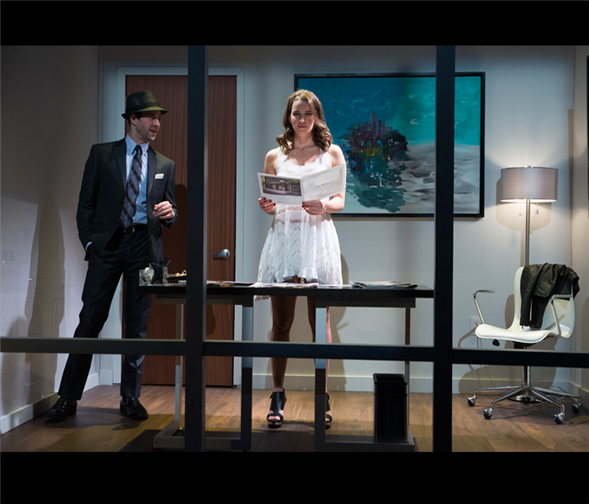Translate Page

A new play digs into apartment envy
---
A Better Place takes audiences into the world of NYC apartment living, where fantasy and reality collide in a clash of socially coded cabinets, artfully decorated living rooms, and the watchful, curious, and potentially critical eyes of neighbors and realtors.
In this new play by Wendy Beckett, now at the Duke on 42nd Street, two apartments face each other across a street. One is a glass-walled unit in a high-end building, sporting black leather ottomans and sleek chrome furnishings in an otherwise minimal space. The other is bursting with books and framed photographs, cramped-but-homey with brick walls, an overstuffed sofa, and an old radiator.
Both apartments imply things about the tenants. Discussing the sleek, modern home, set designer David Arsenault says, "It feels almost like a model unit. It is pristine, and the furniture is well-chosen, well-placed, and well-maintained. The unit has a clearly wealthy feel."
Les, one of the two men living together in the low-end building, obsessively watches the family across the street. He longs for their appliances, imagines their conversations, and wishes himself into their world.
But as Arsenault says, "What you see may not be what the actual reality is. The dressing has almost no personality. There are no photos of the family, just decorative objects." As we eventually learn, this reflects something more than an elite taste for sparseness.
In highlighting the distance between carefully crafted image and messy reality, the production invites us to consider what it means to see and be seen, and how the images that we project to the world relate to our inner lives. Which parts of us are visible through an apartment window, and which are not?
The configuration of the theatre itself underlines these issues. The seats at the Duke have been arranged like an alley, with audience members staring at each other across the playing space. And in fact, Arsenault designed the set so that the audience would have "different experiences on different sides." Sometimes patrons must even turn their heads from side to side in order to try to catch things happening on different parts of the set at the same time. "Given how many times there are different things going on in different rooms, where you are sitting gives you a very different perspective on it all," the designer adds.
This speaks directly to Aresenault's understanding of the play. "So much of the show, and so much of living in NY, is about voyeurism," he says. "We have a fascination with peering into the lives [and apartments] of others. I'm interested in the kind of theatre where the audience is aware that they're an audience – that they're watching and that they're able to watch others watching, and to gauge their own reactions against what they see others doing,"
Ultimately, he continues, he and director Evan Bergman "wanted the audience to have the same experience that the characters were having – not only with watching the characters onstage, but also with each other."
TDF Members: At press time, discount tickets were available for A Better Place. Go here to browse our latest discounts.